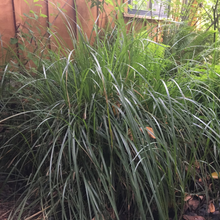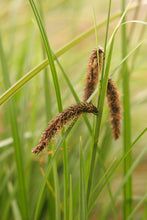Carex obnupta
Slough sedge is an easy-to-grow, evergreen sedge that looks great all year long and functions well in many landscape applications from bioswales to hedgerows. It grows vigorously in wet soils and, over time, creates dense areas of tufted vegetation with drooping dark brown to black inflorescence and seed heads, which are adored by birds from spring to fall.
- Plant type/canopy layer: evergreen, perennial, sedge
- Size at maturity: up to 36" tall, spreads laterally by rhizomes as moisture permits
- Light requirements: full sun, part sun/part shade
- Moisture requirements: moist to wet soil
- Bloom time: n/a
- Growth rate/ease: fast growing, very easy to grow
- Wildlife support: seeds are an excellent food source for many bird species including marsh birds, shorebirds, coots, ducks, upland game birds, and songbirds; overall plant provides excellent cover, bedding and nesting material for ducks, countless other species of birds, beavers, minks, otters. It is also a caterpillar host and larval food source for native butterflies and moths.
- Native habitat/range: common in marshes, wet meadows, stream sides, pond margins, low spots in riparian woodlands, coastal dunes, brackish upper reaches of salt marshes and road ditches, up to 1300m, in much of western North America from British Columbia to California. Portland Plant List - yes.
- Special features & uses: drought tolerant; groundcover; deer resistant; ethnobotanical uses include being an excellent material for weaving and basketry; landscape uses include raingardens, erosion control and bank stabilization
Gardening with Slough Sedge: Slough sedge is ideal for soggy areas and rain gardens where, with adequate moisture, it can thrive in most any light condition, soil type or drainage. It stays green all summer long and, despite being a wet-loving plant, is surprisingly drought-tolerant. In fact, drought conditions can help keep this aggressive plant in check in smaller urban gardens. While it tends to outcompete and overtake smaller herbaceous plants in its path, it is generally self-regulated to areas with sufficient moisture. And though its vigorous nature can give it a bit of a bad rap, it redeems itself ten-fold by its extraordinary ecological function. Slough sedge stabilizes banks, controls erosion, maintains healthy hydrologic function in waterways, and provides sediment retention and nutrient uptake. In this way, it maintains and improves water quality and creates nutrient-rich habitat for aquatic organisms, fish, waterfowl, and predators such as otters, bald eagles, herons, and raccoons to feed (EMSWCD).
Photo Credit 1: Tracy Cozine, Sparrowhawk Native Plants
Photo Credit 2: Karli Del Biondo, Beetles and Bees




